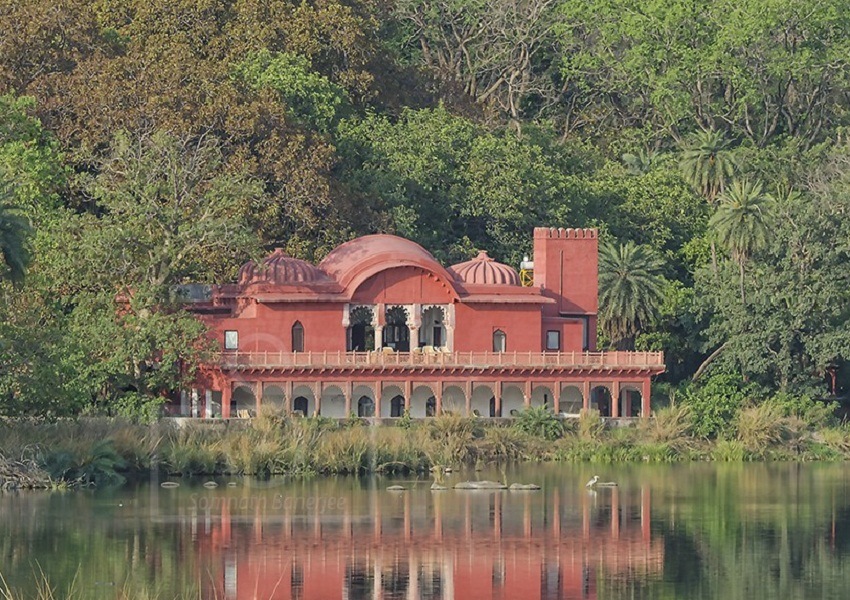Ranthambore Safari Timings For 2024-2025

Jogi Mahal Ranthambore: How To Reach, When to Visit & Tips
March 23, 2024
Journey from Jaipur to Ranthambore: Your Ultimate Travel Guide
June 7, 2024Ranthambore National Park: A Royal Tiger Safari
Ranthambore National Park is a treasure trove for wildlife enthusiasts, offering an exhilarating jungle safari experience unlike any other. Located in the Sawai Madhopur district of Rajasthan, India, this park spans over 392 square kilometers and is renowned for its population of majestic royal tigers.
Ranthambore safari is a popular activity among tourists, allowing them to explore the diverse flora and fauna of the region while catching glimpses of elusive tigers in their natural habitat. The park is also home to a variety of other wildlife, including leopards, sloth bears, deer, and a multitude of bird species.
One of the best ways to embark on a jungle safari in Ranthambore is through a Canter Safari, which is a large, open-air vehicle that can accommodate a larger number of people compared to jeeps. This option is ideal for group travelers or those looking for a more budget-friendly option.
The thrill of spotting a royal tiger amidst the lush greenery of Ranthambore is an unforgettable experience. Visitors can witness these magnificent creatures roaming freely in their natural habitat, going about their daily routines with grace and power.
Apart from tiger sightings, the park’s picturesque landscapes, ancient ruins, and serene lakes add to its charm, making it a must-visit destination for nature lovers and wildlife enthusiasts alike.
For those interested in photography, Ranthambore offers ample opportunities to capture stunning shots of wildlife against the backdrop of rugged terrain and verdant forests. However, it’s essential to respect the park’s rules and regulations to ensure the safety of both visitors and animals.
Planning a visit to Ranthambore National Park promises the adventure of a lifetime, filled with thrilling safari experiences and close encounters with the regal royal tigers. Whether you’re an avid wildlife enthusiast or simply seeking an escape into nature, this park has something for everyone.
Ranthambore National Park: An Introduction
Ranthambore National Park stands as a testament to India’s rich biodiversity and cultural heritage. Nestled in the heart of Rajasthan, Ranthambore National Park is a sanctuary for numerous species of flora and fauna, including the iconic Royal Bengal Tiger. Spanning over 392 square kilometers, this park is dotted with ancient ruins, serene lakes, and dense forests, creating a picturesque backdrop for wildlife enthusiasts and nature lovers alike.
Visitors to Ranthambore National Park can embark on thrilling safaris to catch glimpses of elusive tigers, leopards, sloth bears, and a myriad of bird species in their natural habitat. Whether exploring the park on a jungle safari or a Canter Safari, the experience promises awe-inspiring encounters with some of India’s most magnificent creatures.
With its rich biodiversity and stunning landscapes, Ranthambore National Park continues to captivate the hearts of travelers from around the globe, offering an unforgettable journey into the heart of the wild.
History and Conservation Efforts at Ranthambore
Ranthambore National Park, located in Rajasthan, India, has a captivating history intertwined with conservation efforts. Originally a hunting ground for Maharajas, it was declared a wildlife sanctuary in 1955 and upgraded to a national park in 1980, primarily to safeguard its endangered tigers.
Spanning 1,300 square kilometers, the park is renowned for its rugged terrain and ancient ruins, notably the 10th-century Ranthambore Fort. These historical remnants add to the park’s allure, attracting wildlife enthusiasts and history aficionados alike.
Significant conservation efforts have been implemented to protect the park’s biodiversity, particularly its iconic tiger population. Anti-poaching patrols, habitat restoration, and community engagement initiatives have contributed to the steady recovery of the tiger population.
Ranthambore also serves as a model for ecotourism, promoting sustainable practices while providing economic opportunities for local communities. Guided safaris offer visitors a chance to observe diverse flora and fauna, including tigers, leopards, and numerous bird species.
Advancements in technology, such as satellite tracking and drone surveillance, have further bolstered conservation efforts at Ranthambore.
In essence, the captivating history and unwavering conservation efforts at Ranthambore blend seamlessly, creating a sanctuary where heritage and wildlife preservation thrive hand in hand.
Ranthambore Safari Booking:
Types of Safaris in Ranthambore National Park
If you’re planning a visit to Ranthambore National Park, understanding the types of safaris available is essential. Ranthambore offers various safari options, each providing a unique experience of the park’s diverse wildlife and landscapes.
The most common types of safaris in Ranthambore include jeep safaris and canter safaris. Jeep safaris offer a more intimate experience, allowing smaller groups to explore the park’s trails and spot elusive wildlife up close. Canter safaris, on the other hand, are conducted in larger vehicles, accommodating more people per tour.
Both types of safaris are guided by experienced naturalists who help visitors navigate the park and identify its flora and fauna. Ranthambore Safari Booking is highly recommended to secure your spot in advance, especially during peak seasons when the park attracts a large number of tourists.
For an unforgettable wildlife adventure, don’t miss the opportunity to explore Ranthambore National Park through its diverse safari options.
Ranthambore Safari Timings
| Season | Morning Safari | Afternoon Safari |
| November to January | 7:00 AM to 10:30 AM | 2:00 PM to 5:30 PM |
| February to March | 6:30 AM to 10:00 AM | 2:30 PM to 6:00 PM |
| April to May 15 | 6:00 AM to 9:30 AM | 3:00 PM to 6:30 PM |
| May 16 to June | 6:00 AM to 9:30 AM | 3:30 PM to 7:00 PM |
Ranthambore safari timings are crucial to maximize your chances of encountering the majestic creatures inhabiting this renowned national park. Understanding the Ranthambore timings can significantly enhance your jungle safari experience, allowing you to witness wildlife in their natural habitat during peak activity periods.
Safari time in Ranthambore varies depending on the season and park regulations. Generally, safaris are conducted in two shifts: morning and afternoon. The morning safari typically begins at dawn, offering visitors the opportunity to witness animals stirring from their slumber and embarking on their daily routines. This is often considered the best time for tiger sightings, as they are more active during the cooler hours of the day.
In contrast, the afternoon safari commences later in the day, allowing visitors to explore the park during the warmer hours when wildlife may seek shelter from the sun. While tiger sightings are still possible during this time, other species such as leopards, sloth bears, and various bird species may be more active.
It’s essential to plan your visit in advance and familiarize yourself with the jungle safari timing to make the most of your experience. Booking your safari permits early is advisable, especially during peak tourist seasons, to avoid disappointment.
Moreover, being mindful of the park’s regulations and respecting the natural environment is crucial for preserving the delicate ecosystem of Ranthambore. Visitors are encouraged to follow designated routes, maintain a respectful distance from wildlife, and refrain from littering to minimize their impact on the habitat.
By adhering to the designated Ranthambore safari timings and observing responsible tourism practices, visitors can immerse themselves in the breathtaking beauty of this wilderness sanctuary while contributing to its conservation efforts.
Nearby Attractions and Excursions:
Ranthambore offers a plethora of options for travelers visiting Ranthambore. Situated in the southeastern region of Rajasthan, Ranthambore is renowned for its majestic tigers and captivating wildlife. However, beyond its famed national park, there are numerous other attractions and excursions to explore in the vicinity.
One of the Nearby Attractions is the Ranthambore Fort, a UNESCO World Heritage Site perched atop a hill, offering breathtaking views of the surrounding landscapes. History enthusiasts will marvel at the ancient architecture and rich heritage of this formidable fortress.
For those seeking a cultural experience, a visit to Surwal Lake is a must. This serene water body is a haven for birdwatchers, with its diverse avian population and picturesque scenery. Visitors can indulge in birdwatching or enjoy a tranquil boat ride amidst the natural beauty.
Another highlight among the Nearby Attractions is the Trinetra Ganesh Temple, dedicated to Lord Ganesha and located within the Ranthambore Fort complex. Devotees and tourists alike flock to this sacred site to seek blessings and witness the unique trinetra (three-eyed) idol of Lord Ganesha.
Adventure enthusiasts can embark on thrilling excursions such as jeep safaris and nature trails to explore the rugged terrain and spot elusive wildlife species apart from tigers. These excursions offer an adrenaline-pumping experience while showcasing the diverse flora and fauna of the region.
Shilpgram in Ranthambore is a cultural village showcasing the rich heritage of Rajasthan. Visitors can explore traditional crafts, watch folk performances, and purchase handmade items. It’s a great place to experience local culture and support artisans, making it a must-visit spot near Ranthambore National Park.
Jogi Mahal in Ranthambore is a beautiful guest house located near the Padam Talao, the largest lake in the park. Once a hunting lodge for royalty, it now offers stunning views and a chance to relax amidst nature. The ancient banyan tree nearby is also a major attraction.
Padam Talao is the largest lake in Ranthambore National Park, often visited by various wildlife, including tigers. The picturesque setting makes it a perfect spot for photography and wildlife observation. The Jogi Mahal is situated on its banks, adding to the charm of this serene location.
Kachida Valley is an excellent spot for those looking to explore beyond the usual safari routes. Located on the outskirts of Ranthambore National Park, this valley is home to a significant population of panthers and sloth bears. The scenic beauty and relative tranquility make it a hidden gem for nature lovers.
Raj Bagh Talao is another prominent lake in Ranthambore, surrounded by ancient ruins and lush greenery. It is a favorite haunt of wildlife, especially tigers and deer. The serene environment combined with the historical backdrop makes it a captivating spot for visitors.
Ranthambore’s diverse attractions and excursions offer something for everyone, whether you are a wildlife enthusiast, a history buff, or a culture seeker. Each location provides a unique glimpse into the natural beauty and rich heritage of this remarkable region.
Moreover, the surrounding villages provide a glimpse into the traditional Rajasthani way of life, with their vibrant culture, colorful handicrafts, and mouthwatering cuisine.
Best Time To Visit Ranthambore
Ranthambore National Park offers a captivating wildlife experience, attracting nature enthusiasts and wildlife photographers from around the globe. Timing is crucial for those planning a visit to make the most of this wilderness haven. Understanding the best time to visit Ranthambore ensures optimal wildlife sightings and an unforgettable adventure.
The best time to visit Ranthambore is during the dry season, from October to April. This period, marked by mild temperatures and minimal rainfall, facilitates excellent visibility and increased chances of spotting elusive creatures such as tigers, leopards, and sloth bears. The months of November to March are particularly ideal, as the vegetation thins out, making wildlife easier to spot amidst the deciduous forests and grasslands.
Conversely, the monsoon season, from July to September, brings heavy rainfall, resulting in lush greenery but hindering wildlife sightings due to dense foliage and limited accessibility to certain areas of the park. Similarly, the scorching summer months, from May to June, witness high temperatures, causing animals to seek shelter, and reducing the chances of sightings.
Planning a visit to Ranthambore National Park during the dry season maximizes the opportunity for thrilling wildlife encounters and unforgettable experiences amidst the untamed beauty of nature.
Ranthambore Tiger Resort stands out as the best resort in Ranthambore, offering luxurious accommodations and proximity to the park. It’s advisable to book in advance, especially during peak seasons, to secure your stay. Additionally, considering factors like weather and crowd density can enhance your experience. For an unforgettable wildlife adventure, plan your visit strategically and choose accommodations like Ranthambore Tiger Resort for a comfortable stay.




